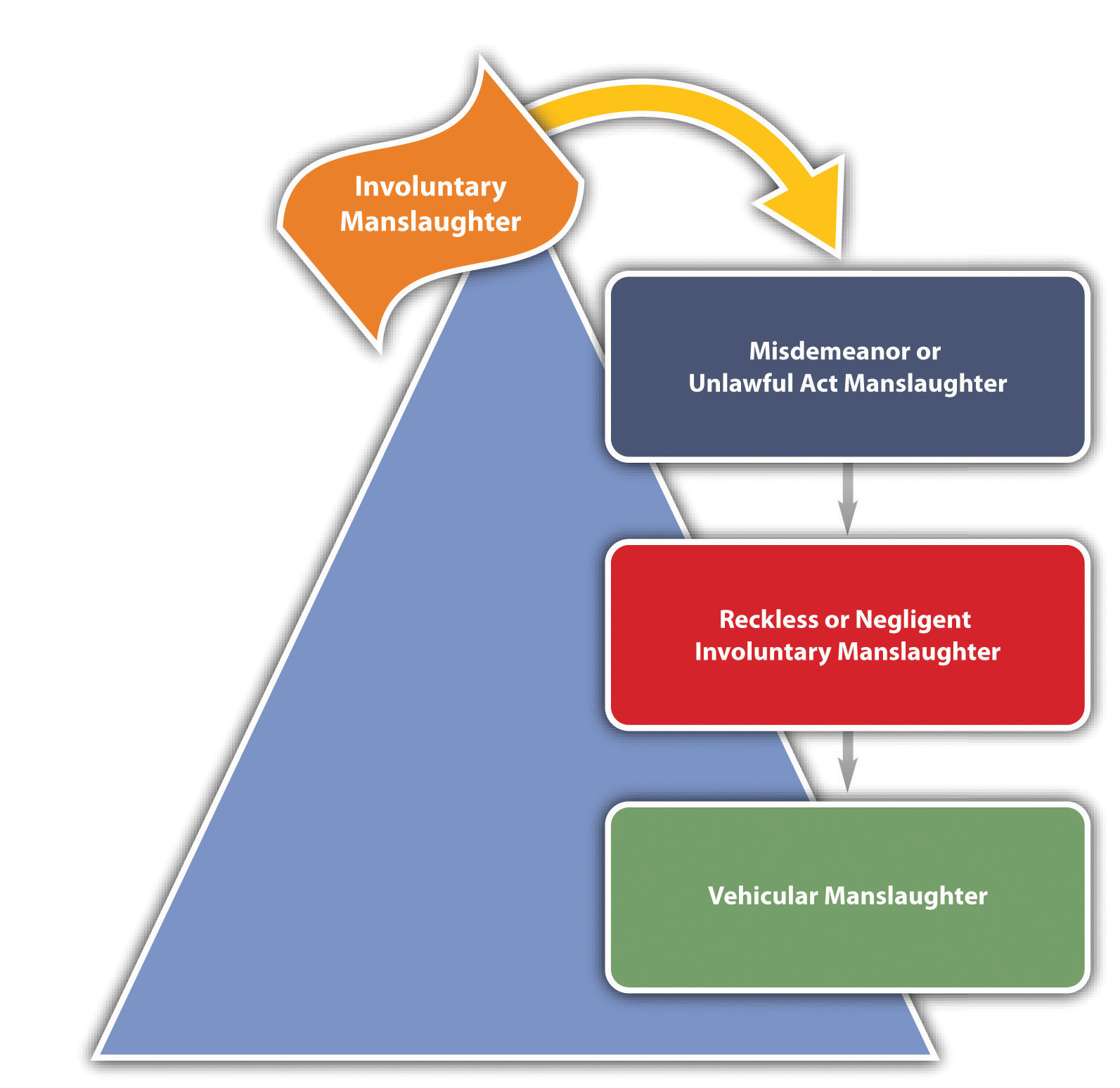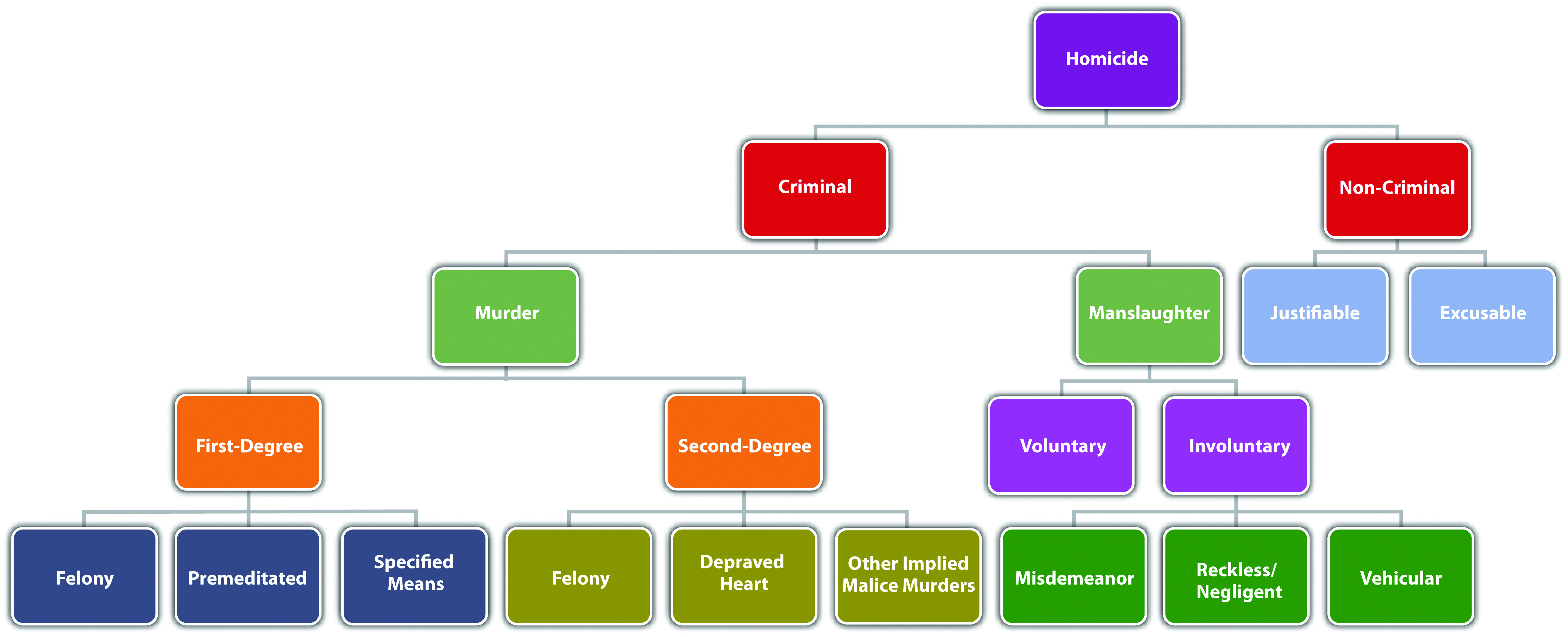
What distinguishes murder from manslaughter is the criminal intent element. Manslaughter is an unlawful killing without malice or murder intent (N.R.S. § 200.040, 2011). The criminal act, causation, and harm elements of manslaughter and murder are fundamentally the same. Thus criminal intent is the only manslaughter offense element that is discussed in this section.
Manslaughter has two basic classifications: voluntary and involuntary. Voluntary manslaughter has the same criminal intent element as murder. In fact, a voluntary manslaughter killing is typically supported by express malice, specific intent to kill, or purposely. However, in a voluntary manslaughter, an emotional state called a heat of passion negates the murder intent. An adequate provocation from the victim inspires the heat of passion (Tenn. Code Ann., 2010). The Model Penal Code does not require adequate provocation from the victim per se, but it does have a similar provision that reduces murder to manslaughter when there is a reasonable explanation or excuse (Model Penal Code § 210.3(1)(b)).
The adequacy requirement is essential to any voluntary manslaughter analysis. Many defendants are provoked and thereafter kill with murder intent. Nonetheless, most provocations are not adequate to drop the crime from murder to manslaughter. The victim’s provocation must be serious enough to goad a reasonable person into killing (People v. Steele, 2011). A reasonable person is a fictional and objective standard created by the trier of fact. Of course, the defendant must actually be provoked, which is a subjective standard (People v. Steele, 2011).
Revisit the situation discussed in Section 9 “Example of a Spontaneous Killing”, in which Dillon kills his supervisor Frank with a brass paperweight after Frank fires him. Clearly, Frank’s conduct provokes Dillon into killing Frank. However, getting fired would not provoke a reasonable person into a killing frenzy. In fact, reasonable people are fired all the time and learn to live with it peacefully. Therefore, in this example, Dillon’s crime is most likely murder, not voluntary manslaughter.
A traditional example of provocation that is adequate to reduce a crime from murder to manslaughter is an observation by one spouse of another spouse in the act of adultery (Ohio v. Shane, 2011). For example, José comes home from work early and catches his wife in bed with his best friend. He becomes so enraged that he storms over to the dresser, grabs his handgun, and shoots and kills her. Clearly, José acts with intent to kill. However, the victim provoked this intent with an act that could cause a reasonable person to kill. Thus José has probably committed voluntary manslaughter in this case, not murder.
Other examples of adequate provocation are when the homicide victim batters the defendant and a killing that occurs during a mutual combat (Ohio v. Shane, 2011). Cases have generally held that words alone are not enough to constitute adequate provocation (Girouard v. State, 2011). Thus in the adequate provocation example in Section 9 “Example of Adequate Provocation”, if a friend told José that his wife was committing adultery, and José responded by shooting and killing his wife, this would probably be murder, not voluntary manslaughter.
The second requirement of voluntary manslaughter is that the killing occur during a heat of passion. Defendants generally exhibit rage, shock, or fright when experiencing a heat of passion. This emotional state negates the calm, deliberate, intent to kill that supports a charge of murder. However, heat of passion mental states are typically brief in duration. Thus there cannot be a significant time lapse between the victim’s provocation and the killing (State v. Cole, 2010). Analyze the adequate provocation example discussed in Section 9 “Example of Adequate Provocation”. If José waits until the next day to shoot and kill his wife, the crime is most likely premeditated first-degree murder, not voluntary manslaughter.
Figure 9.7 Diagram of Voluntary Manslaughter
| Voluntary Manslaughter | ||
| Adequate provocation from the victim | Killing occurs during a heat of passion | |
| Enough to cause a reasonable person to kill | The defendant must actually be provoked into killing in a heat of passion | No significant time lapse between heat of passion and the killing |
Involuntary manslaughter is an unlawful killing that completely lacks murder intent. Involuntary manslaughter is distinguishable from voluntary manslaughter, which generally includes a murder intent that has been negated. Involuntary manslaughter generally can be classified as misdemeanor manslaughter , reckless or negligent involuntary manslaughter , or vehicular manslaughter .
Misdemeanor manslaughter, also called unlawful act manslaughter, is a criminal homicide that occurs during the commission or attempted commission of a misdemeanor. The Model Penal Code completely rejects misdemeanor manslaughter. There is a trend to follow the Model Penal Code’s example and abolish misdemeanor manslaughter. Most states that prohibit misdemeanor manslaughter only include misdemeanors that are inherently dangerous to life in the criminal statute, excluding strict liability misdemeanors or malum prohibitum crimes (K.S.A., 2010). A minority of states and the federal government include strict liability or malum prohibitum crimes in their misdemeanor manslaughter statutes (21 O.S., 2010). In either jurisdiction, the defendant need only possess the criminal intent for the misdemeanor to be guilty of the killing.
Roberta points an unloaded gun at Jennifer to scare her into breaking up with Roberta’s ex-boyfriend. This crime is called brandishing a weapon and is often classified as a misdemeanor. At the sight of the gun, Jennifer suffers a heart attack and dies. Roberta has most likely committed misdemeanor manslaughter in this case. Brandishing a weapon is not always inherently dangerous to life. However, if Jennifer has a heart attack and dies because of Roberta’s commission of this misdemeanor offense, Roberta still could be criminally responsible for misdemeanor manslaughter in many jurisdictions.
States and the federal government also criminalize reckless or negligent involuntary manslaughter (Ala. Code, 2011). Reckless or negligent involuntary manslaughter is a more common form of manslaughter than misdemeanor manslaughter. The Model Penal Code defines reckless homicide as manslaughter and a felony of the second degree (Model Penal Code § 210.3). The Model Penal Code defines negligent homicide as a felony of the third degree (Model Penal Code § 210.4).
Reckless involuntary manslaughter is a killing supported by the criminal intent element of recklessness. Recklessness means that the defendant is aware of a risk of death but acts anyway. Negligent involuntary manslaughter is a killing supported by the criminal intent element of negligence. Negligence means that the defendant should be aware of a risk of death, but is not. This category includes many careless or accidental deaths, such as death caused by firearms or explosives, and a parent’s failure to provide medical treatment or necessities for his or her child. Reckless and negligent criminal intent is discussed in detail in Chapter 4 “The Elements of a Crime”.
As stated in Section 9.5.1 “Depraved Heart Murder”, reckless or negligent involuntary manslaughter is often similar to second-degree depraved heart murder. If the prosecution charges the defendant with both crimes, the trier of fact determines which crime is appropriate based on the attendant circumstances.
Steven, an off-duty sheriff’s deputy, brings his shotgun into the local rifle shop to be repaired. Steven thinks that the shotgun is unloaded and hands it to the employee with the safety off. Unfortunately, the gun is loaded and discharges, shooting and killing the employee. In this case, Steven should know that at certain times the safety on his shotgun must always be on because he is a registered gun owner and a sheriff’s deputy who has been trained to handle guns. However, Steven is unaware of the risk and believes that the gun is unloaded. If the employee dies, Steven could be convicted of negligent involuntary manslaughter in jurisdictions that recognize this crime. If Steven is in a jurisdiction that only recognizes reckless involuntary manslaughter, the prosecution may have to prove a higher degree of awareness, such as Steven’s knowledge that the shotgun was loaded.
Vehicular manslaughter is typically either the operation of a motor vehicle with recklessness or negligence resulting in death or the operation of a motor vehicle under the influence of alcohol or drugs resulting in death (N.Y. Penal Law §125.12, 2010). Some states have specific vehicular manslaughter statutes (Cal. Penal Code, 2011). In states that do not, the defendant could be prosecuted under a jurisdiction’s misdemeanor or unlawful act manslaughter statute if the defendant violates a vehicle code section. Vehicular manslaughter can also be prosecuted under a jurisdiction’s reckless or negligent involuntary manslaughter statute, depending on the circumstances. If the defendant uses a motor vehicle as a weapon to kill the victim, the intent to kill is present and the appropriate crime would be murder.
Figure 9.8 Diagram of Involuntary Manslaughter

Voluntary and involuntary manslaughter typically have a more lenient punishment scheme than murder because the criminal intent is less heinous (N.R.S. § 200.080, 2011). Often manslaughter functions as an imperfect defense to murder, based on the less serious sentencing options. In general, voluntary manslaughter is graded higher than involuntary manslaughter (N.R.S. § 200.090, 2011). Some states divide manslaughter into degrees, rather than classifying it as voluntary and involuntary, with first-degree manslaughter punished more severely than second-degree manslaughter (N.Y. Penal Law §125.20, 2011). The Model Penal Code grades all manslaughter as a felony of the second degree (Model Penal Code § 210.3(2)) and grades negligent homicide as a felony of the third degree (Model Penal Code § 210.4(2)).
Figure 9.9 Diagram of Homicide

Answer the following questions. Check your answers using the answer key at the end of the chapter.
Should Killing an Abortion Doctor Be Voluntary Manslaughter?
Scott Roeder left his pew during a church service, walked up to a well-known abortion doctor, and deliberately shot him in the head, killing him. During Roeder’s trial for first-degree premeditated murder, the defense asked the court to allow a second charge of voluntary manslaughter. The defense claimed that defendant Roeder was acting in defense of others in the attempt to save the lives of unborn children (USA Today, 2010).
Check your answer using the answer key at the end of the chapter.
Scott Roeder Convicted of Murder
Scott Roeder’s murder verdict is shown in this video: